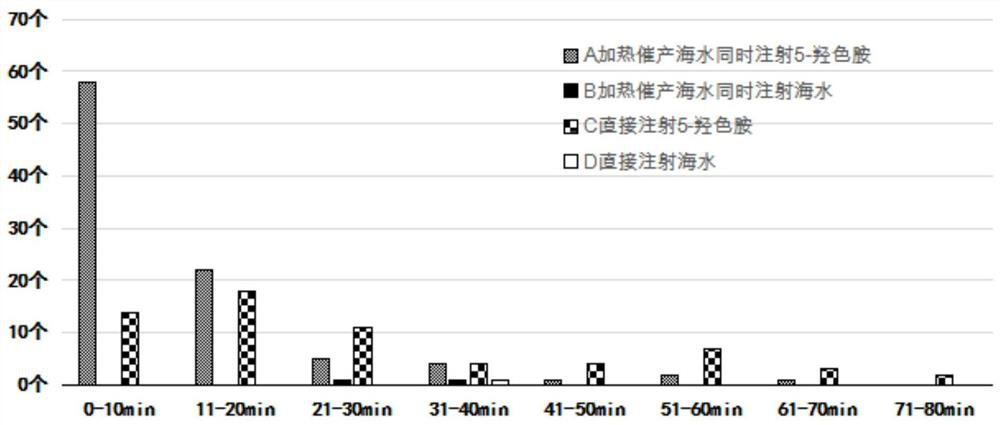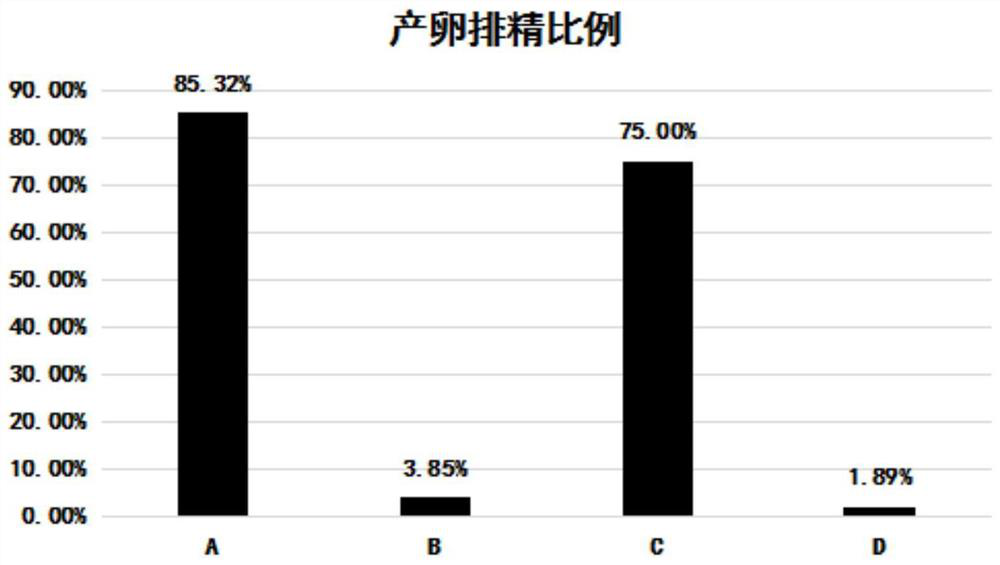Method for inducing oviposition and spermiation of bivalve mollusks
A technology for bivalve molluscs and shells, which is applied in the field of aquaculture and can solve problems such as time-consuming, labor-intensive, low success rate, and unstable egg production
- Summary
- Abstract
- Description
- Claims
- Application Information
AI Technical Summary
Problems solved by technology
Method used
Image
Examples
Embodiment 1
[0020] A method for inducing philippine clams to lay eggs and ejaculate, the specific steps are as follows:
[0021] 1) The filtered seawater uses the seawater from the growth area of Philippine clams. After sand filtration and disinfection, connect the 0.22μm filter element with a syringe, push the seawater out of the filter element, and prepare 5-HT (5-hydroxytryptamine) with a concentration of 2mM with the filtered seawater. Store at 4°C and protect from light.
[0022] 2) Add filtered seawater to a 1L transparent small bucket (spawning bucket) in advance, heat the water bath and raise the temperature to 7-8°C higher than normal seawater, and rise to 30±1°C, so that the broodstock to be produced can be put into the small bucket .
[0023] 3) 30 Philippine clam broodstocks with mature selective glands were washed and placed in a dissecting tray, and filtered seawater with a depth of 1 cm was added to the dissecting tray, and the shells were opened (it took about 3 hours f...
Embodiment 2
[0028] In order to further prove the effect of serotonin to induce labor, four groups of experiments were set up in this embodiment, and the ovulation and oviposition of Philippine clams were counted in the first 80 minutes (statistics were performed once every 10 minutes). The results are shown in figure 1 and figure 2 . Group A: heating seawater + injecting 5-HT; group B: heating seawater + injecting seawater; group C: not heating seawater + directly injecting 5-HT; group D: not heating seawater + injecting seawater. The ratio of individual ovulation and oviposition within 20 minutes in experimental group A was the highest, reaching 53.2%, which was much higher than that of group C (16.7%) without heating seawater. Neither group B nor D oviposited. At the end of the experiment, the total induced labor rate in group A reached 85.3%, that in group C was 75.0%, and that in groups B and D was less than 5%. The results showed that, for the two experimental groups A and C injec...
Embodiment 3
[0030] A method for inducing Pacific oyster to lay eggs and ejaculate, the specific steps are as follows:
[0031] 1) Filtered seawater uses seawater from the Pacific oyster growth area. After sand filtration and disinfection, connect the 0.22μm filter element with a syringe, push the seawater out of the filter element, and prepare 5-HT (5-hydroxytryptamine) with a concentration of 2mM with the filtered seawater. 4 Store at ℃ and avoid light.
[0032] 2) Add filtered seawater to a 1L transparent small bucket (spawning bucket) in advance. The normal temporary water temperature for Pacific oyster broodstock is 18-20°C, and the heated water temperature for induced oyster production is 22-23°C, so that the broodstock that is ready to give birth can be released. into the bucket.
[0033] 3) 30 broodstocks with mature selective glands were washed and placed in a dissecting tray. Added filtered seawater with a depth of 3cm to the dissecting tray and waited for their shells to open (...
PUM
 Login to View More
Login to View More Abstract
Description
Claims
Application Information
 Login to View More
Login to View More - R&D
- Intellectual Property
- Life Sciences
- Materials
- Tech Scout
- Unparalleled Data Quality
- Higher Quality Content
- 60% Fewer Hallucinations
Browse by: Latest US Patents, China's latest patents, Technical Efficacy Thesaurus, Application Domain, Technology Topic, Popular Technical Reports.
© 2025 PatSnap. All rights reserved.Legal|Privacy policy|Modern Slavery Act Transparency Statement|Sitemap|About US| Contact US: help@patsnap.com


